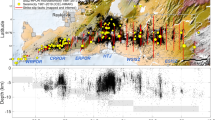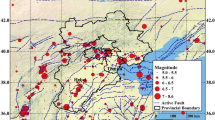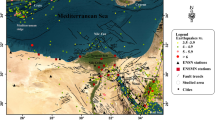Abstract
The seismic hazard has been computed for the city of Dehradun, Uttarakhand, India. The city lies in the Himalayan foothills between two faults: the Main Boundary Thrust (MBT) and the Himalayan Frontal Fault (HFF). The contributions from these two faults have been modelled differently in a probabilistic model. While the MBT has been modelled with a Poissonian earthquake distribution, the HFF has been modelled both with a characteristic earthquake recurrence model and a Poissonian model. The hazard scenarios reveal different patterns depending on the classical approaches and the characteristic models applied, and the obtained results indicate that Dehradun may experience PGA shaking around 2.2 m/s2 for 225 years return period and around 4.6 m/s2 for a 2,500 years return period.














Similar content being viewed by others
References
Acharya, S. K. and Narula, P. L. (1998) Seismotectonic scenario of Himalaya and its recent developments, 11th Symp. Earthquake Engineering, Roorkee, Vol I, 3-20.
Ahmed, J (2008) Seismic Microzonation of Mega cities, PhD Thesis, Department of Earthquake Engineering, Indian Institute of Technology, Roorkee
Akkar, S. and J.J. Bommer (2007a): Empirical prediction equations for peak ground velocity derived from strong motion records from Europe and Middle East. Bull. Seism. Soc. Am. 97(2), 511–530.
Akkar, S. and J.J. Bommer (2007b): Prediction of Elastic Displacement Response Spectra in Europe and the Middle East. Earthq. Eng. Struct. Dyn., in press.
Ambraseys, N.N. and R. Bilham (2000). A note on the Kangra M S = 7.8 earthquake of 4 April 1905. Current Science 79(1), 45–50.
Ambraseys, N., and D. Jackson (2003), A note on early earthquakes in northern India and southern Tibet, Curr. Sci., 84(4), 571-582
Ambraseys, N., and J. Douglas (2004), Magnitude calibration of north Indian earthquakes, Geophys. J. Int., 159, 165-206
Ambraseys, N.N., J. Douglas, S.K. Sarma, and P.M. Smit. (2005): Equations for the Estimation of Strong Ground Motions from Shallow Crustal Earthquakes Using Data from Europe and the Middle East: Horizontal Peak Ground Acceleration and Spectral Acceleration. Bulletin of Earthquake Engineering 3, 1–53.
Banerjee, P. and R. Burgmann (2002), Convergence across the northwest Himalaya from GPS measurements, Geophysical Research Letters, Vol. 29, no. 13, doi:10.1029/2002gl015184
Bhatia SC, Kumar RM, Gupta HK (1999) A probabilistic seismic hazard map of India and adjoining regions. Ann Geofis 42(6):1153–1164
Bilham, R. (1995), Location and magnitude of the 1833 Nepal earthquake and its relation to the rupture zones of contiguous great Himalayan earthquakes, Curr. Sci., 69(2), 155-187.
Bilham, R. (2004), Earthquakes in India and the Himalaya: Tectonics, geodesy and history, Ann. Geophys., 47(2–3), 839-858.
Bilham, R., and N. Ambraseys (2005), Apparent Himalayan slip deficit from the summation of seismic moments for Himalayan earthquakes, 1500–2000, Curr. Sci., 88(10), 1658-1663.
Bilahm, R, V. K. Gaur and P. Molnar (2001) EARTHQUAKES: Himalayan Seismic Hazard, Science 24, Vol. 293. no. 5534, pp. 1442 - 1444
Bilham, R., Blume, F., Bendick, R. and Gaur, V.K., 1998. Geodetic constraints on the translation and deformation of India, implications for future great Himalayan earthquakes. Current Science, 74: 213-229.
Bilham, R., K. Larson, J. Freymueller and Project IDYLHIM Members (1997): GPS measurements of present day convergence across the Nepal Himalaya, Nature, London, 386, 61-64.
Brune, J.N., 1996. Particle motions in a physical model of shallow angle thrust faulting. Proceedings of the Indian Academy of Sciences: Earth and Planetary Sciences, 105: L197-L206.
Douglas, J. (2004): Ground estimation equations 1964-2003; a comprehensive worldwide summary of strong-motion attenuation relationships for peak ground acceleration and spectral ordinates (1969 to 2000) with corrections and additions. Imperial College Research Report No. 04-001-SM.
Habermann, R.E., (1987) Man-made changes of Seismicity rates, Bull. Seism. Soc. Am., 77, 141-159.
Hough, S. E., Bilham, R., Ambraseys, N., and Feldl, N. (2005) Revisiting the 1897 Shillong and 1905 Kangra earthquakes in northern India: Site response, Moho reflections and a triggered earthquake, Special Section: Intraplate Seismicity, Current Science, Vol. 88, No. 10, 1632-1638.
Jackson, M.E. and Bilham, R., 1994. 1991-1992 GPS measurements across the Nepal Himalaya. Geophysical Research Letters, 21(12): 1169-1172.
Jain, S.K., A. Roshan, J. Arlekar, and P. Basu (2000): Empirical attenuation relationships for the Himalayan earthquakes based on Indian strong motion data. Proceedings of the Sixth International Conference on seismic Zonation.
Jalote, P.M. and Mithal, R.S. (1971) Geological and tectonic evaluation of the recent activity along the Krol Thrust in the Dun valley. Jour. Engineering Geology, 6, 421-428.
Khademi M.H. (2002): Attenuation of peak and spectral accelerations in the Persian Plateau. Proceedings of the Twelfth European Conf. on Earthq. Eng., Paper No. 330.
Khattri KN, Rogers AM, Perkins DM, Algermissen ST (1984) A seismic hazard map of India and adjacent areas. Tectonophysics 108:93–134
Kumar, S., S.G. Wesnouski, T.K. Rockwell, D. Ragona, V.K.Thakur, and G.G. Seitz (2001): Earthquake recurrence and rupture dynamics of Himalayan frontal thrust, India, Science 14 December 2001: Vol. 294. no. 5550, pp. 2328 – 2331.
Kumar, S (2003) The Himalayan Frontal Thrust (HFT) is not blind, 2003 Seattle Annual Meeting (November 2–5, 2003)
Kumar, S. and A.K. Mahajan (2001): Seismotectonics of the Kangra region, Northwest Himalaya. Tectonophysics 331, 359–371.
Kumar, S., S.G. Wesnousky, T.K. Rockwell, R.W. Briggs, V.C. Thakur, and R. Jayangondaperumal, R. (2006): Paleoseismic evidence of great surface rupture earthquakes along the Indian Himalaya, J. Geophys. Res., 111(B3), B03304, doi:10.1029/2004JB003309.
Kumar, S., Wesnousky, S. G., Jayangondaperumal, R., Nakata, T., Kumahara, Y., and Singh, V (2010), Paleoseismological evidence of surface faulting along the northeastern Himalayan front, India: Timing, size, and spatial extent of great earthquakes, Journal of Geophysical Research, Vol. 115, B12422, doi:10.1029/2009JB006789
Lave, J. and Avouac, J.P., 2000. Active folding of fluvial terraces across the Siwaliks Hills, Himalayas of central Nepal. Journal of Geophysical Research, 105(B3): 5735-5770.
Mahajan, A. K., V. C. Thakur, M.L. Sharma and M. Chauhan (2010). Probabilistic seismic hazard map of NW Himalaya and its adjoining area, India. Nat Hazards (2010) 53:443–457. doi:10.1007/s11069-009-9439-3
Mahajan, A. K., V. Mihailov and D. Dojcinvoski (2002) A preliminary probabilistic seismic hazard assessment of northwest Himalaya, 12SEE, Roorkee, 277-286
Martin, S. and Szeliga, W(2010), A Catalog of Felt Intensity Data for 570 Earthquakes in India from 1636 to 2009, Bulletin of the Seismological Society of America, Vol. 100, No. 2, 562-569,
Mugnier, J. L., P. Huyghe, A.P. Gajurel, D. Becel, (2005) Frontal and piggy-back seismic ruptures in the external thrust belt of Western Nepal, Journal of Asian Earth Sciences 25 (2005) 707–717.
Mugnier, J.L., Leturmy, P., Mascle, G., Huyghe, P., Chalaron, E., Vidal, G., Husson, L., Delcaillau, B., 1999. The Siwaliks of western Nepal: I geometry and kinematics. Journal of Asian Earth Sciences 17, 629–642.
Mukhopadhyay, D. K and Mishra P. (2006) Himalayan Frontal Fold-Thrust Belt, NW India: Geometry, Structural Evolution, and Hydrocarbon Prospects, extended abstract, AAPG 2006 International Conference and Exhibition, Perth, Australia, November 5-8, 2006.
Narula, P. L. (1991) Seismotectonic evaluation of north west Himalaya, Rec. Geol. Sur. India, V. 128, pt 8.
Narula, P. L. (1992) Neotectonic activity, seismicity and related contemporary deformations in the NW Himalaya, Symp. On Himalayan Geology, Japan, 33-36.
Narula, P. L. and Shome, S. K. (1992) Macroseismic studies of recent earthquakes in NW Himalaya, Current Science, V. 62, No. 1-2, 24-33.
Narula, P. L., Ravi Shanker and Chopra, S. (2000) Rupture mechanism of Chamoli earthquake on March 29, 1999 and its implications for seismotectonics of Garhwal Himalaya, J. Geol. Soc. India, Vol. 55, 493-503.
Ni, J. and Barazangi, M. (1984) Seismotectonics oftlle Himalayan Collision Zone, Geometry of the Underthrusting Indian Plate Beneath the Himalaya, 1. Geophys. Res.,89, 1147-1163.
Ordaz, M., A. Aguilar, and J. Arboleda (2003): Crisis 2003. Program for computing seismic Hazard, Ver. 3.01.
Pandey, M.R., Tandukar, R.P., Avouac, J.P., Lave, J. and Massot, J.P., 1995. Interseismic strain accumulation on the Himalayan crustal ramp (Nepal). Geophysical Research Letters, 22(7): 751-754.
Press and Seiver (1986) Earth, 4th Edition, W.H. Freeman, New York, New York, USA.
Sadigh K., C. Chang, J. Egan, F. Makdisi and R. Youngs (1997): Attenuation relationships for shallow crustal earthquakes based on California strong motion data. Seismol. Res. Lett., 68/1
Schwartz, D. P., and J. Coppersmith (1984) Fault behavior and characteristic earthquakes: examples from Wasatch and San Andreas faults, J. Geophys. Res. 89, 5681–5698.
Seeber, L., and Armbruster, J. G. (1981) Great detachment earthquakes along the Himalayan arc and long term prediction: An international review, Am Geophys. Union (Maurice Ewing Series),
Sharma, M. and H. Bungum (2006): New strong ground-motion spectral acceleration relations for the Himalayan region. Proc., 1st European on Conf. Earthq. Eng. and Seism., Geneva, 3-8 September 2006, Paper No. 1459, 8 pp.
Sharma, M. L. (2003) Seismic hazard in Northern India region Seismological Research Letters, Vol. 74, Number 2, March/April 2003, 140-146.
Sharma, M. L. and R. Dimri, (2003) Seismic hazard estimation and zonation of northern Indian region for bed rock ground motion, Journal of Seismology and Earthquake Engineering, Vol 5, No. 2, 23-34
Sharma, M. L. J. Douglas, H. Bungum and J. Kotadia (2009) Ground motion predicting equations on data from the Himalayan and Zagros regions, Jour. Earthquake Engineering, 13:8, 1191-1210.
Sharma, M.L. (1998): Attenuation relationship for estimation of peak ground horizontal acceleration using data from strong-motion arrays in India, Bull. Seism. Soc. Am. 88(4), 1063–1069.
Sharma and Dubey (2000) Seismological aspects, a report on Chamoli earthquake of March 29, 1999, Publ by Department of Earthquake Engineering, Roorkee.
Srikantia, S.V. and Bhargava, O.N. (1998) Geology of Himachal Pradesh. Geol. Soc. India, pp. 406.
Stepp, J.C. (1973): Analysis of completeness of the earthquake sample in the Puget Sound area. In S.T, Harding (ed.): Contributions to Seismic Zoning, NOAA Technical Report ERL 267-ESL 30, 16-28.
Tandon (1956): Zones of India liable to earthquake damage. Ind J Meteorol Geophys 10:137–146
Thakur, V. C. (2004), Active tectonics of Himalayan Frontal Thrust and Seismic Hazard to Ganga Plain, Current science, Vol. 86, No. 11, 1554-1560.
Thakur, V.C., V. Sharma, and A.K. Mundepi (2000): Seismicity of the great 1905 Kangra earthquake meizoseismal region in Kangra-Chamba, NW Himalaya. Tectonophysics 326, 289–298.
Valdiya, K. S., 1986, Neotectonic activities in the Himalayan belt. In Proceedings of the International Symposium on Neotectonics in South Asia (Dehra Dun: Survey of India), pp. 241- 251.
Wesnousky, S. G. and C. H. Scholz, K. Shimazaki and T. Matsuda (1983) Earthquake frequency distribution and the mechanics of faulting, Journal of Geophysical Research, Vol. 88, No. Bll, 331-9340.
Wesnousky, S.G., Kumar, S., Mohindra, R. and Thakur, V.C., 1999. Uplift and convergence along the Himalayan Frontal Thrust of India. Tectonics, 18(6): 967-976.
Acknowledgments
The present study was made under the Indo–Norwegian cooperation program as funded by the Norwegian Government. Several suggestions by John Douglas represented important contributions for enhancing the manuscript.
Author information
Authors and Affiliations
Corresponding author
Rights and permissions
About this article
Cite this article
Sharma, M.L., Lindholm, C. Earthquake Hazard Assessment for Dehradun, Uttarakhand, India, Including a Characteristic Earthquake Recurrence Model for the Himalaya Frontal Fault (HFF). Pure Appl. Geophys. 169, 1601–1617 (2012). https://doi.org/10.1007/s00024-011-0427-7
Received:
Revised:
Accepted:
Published:
Issue Date:
DOI: https://doi.org/10.1007/s00024-011-0427-7




